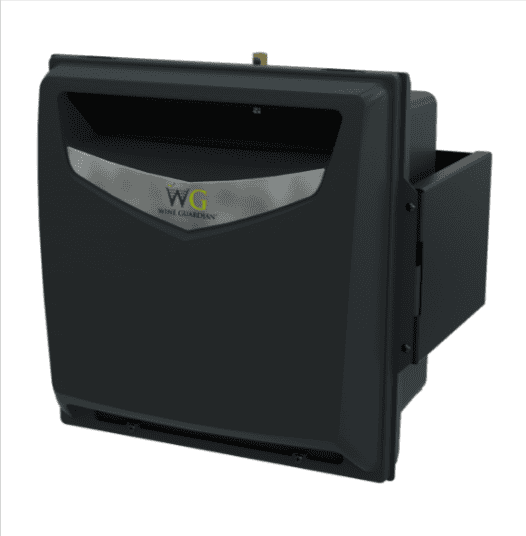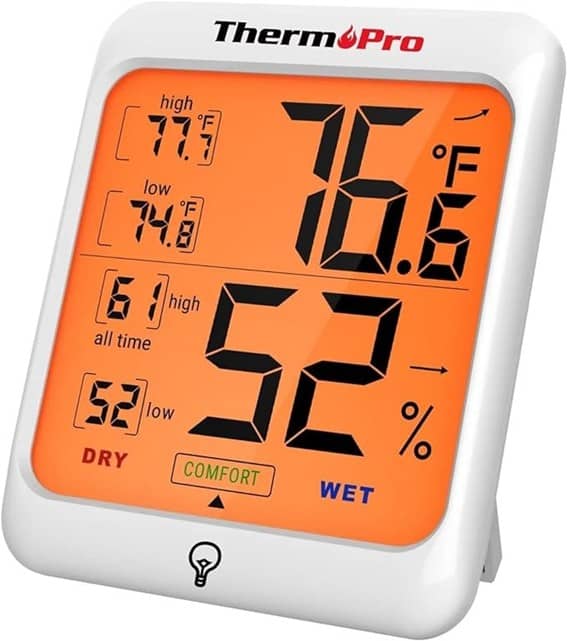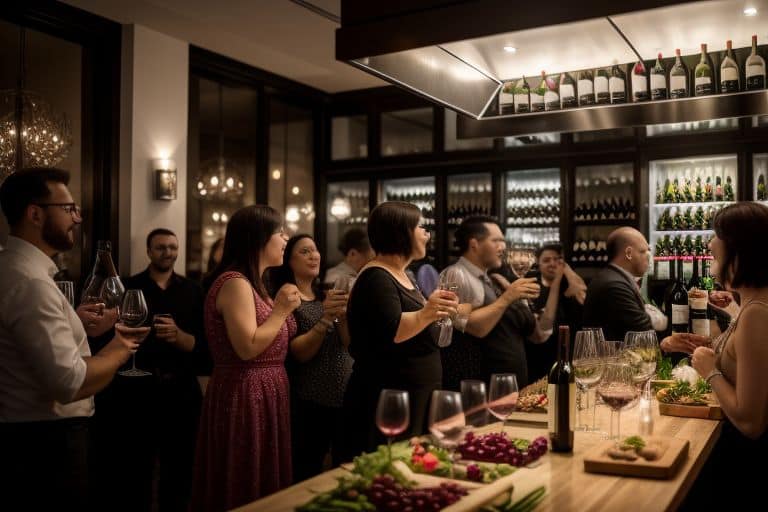For wine enthusiasts and collectors, proper storage conditions are crucial for preserving the quality, flavor, and value of their prized bottles.
While temperature control often takes center stage in wine storage discussions, humidity management is equally vital yet frequently overlooked. At Wine Guardian, experts believe that “temperature and humidity go hand in hand” when it comes to wine preservation systems. This comprehensive review explores the top wine humidity control solutions available in 2025, helping you make an informed decision to protect your valuable collection.
An inadequate humidity level can significantly impact the quality and longevity of your wine. When humidity is too low, wine corks can dry out, compromising the seal and allowing air to enter the bottle, which prematurely ages the wine. Conversely, excessive humidity can damage labels and potentially lead to mold growth. The ideal relative humidity for wine storage typically falls between 50-70%, creating the perfect environment for long-term aging and preservation.
Whether you’re a seasoned collector with a dedicated cellar or a casual enthusiast with a small wine refrigerator, this guide will help you identify the best wine humidity controllers to maintain optimal conditions for your wine collection in 2025.
Welcome to Didi Somm, and Cheers!
Important Notice: The information in this article is for general and public information purposes only. It solely reflects Didi Somm’s or his Staff’s opinion, and no responsibility can be assumed for errors or omissions in the service’s contents. For details, please check the Disclaimer at the bottom of the homepage.
Key Takeaways
- The ideal humidity range for wine storage is 50-70%, with most experts recommending 60-65% for optimal cork preservation
- Humidity control is critical for maintaining cork integrity and preventing premature oxidation
- Integrated systems that combine temperature and humidity control offer the most seamless solution
- Smart controllers with WiFi connectivity provide remote monitoring and alert capabilities
- Standalone humidifiers and monitoring devices can supplement existing wine storage systems
- Different solutions are available for various cellar sizes and collection requirements
- Proper humidity management extends the lifespan and preserves the quality of your wine investment
Affiliate Disclaimer: This page may include Affiliate links, meaning that we get a commission if you decide to purchase through this site at no extra cost to you. Please read our Disclaimer for your information.
Understanding Wine Humidity Requirements
Let me tell you something I learned the hard way about wine storage—humidity isn’t just some fancy concept that snooty collectors obsess over. After investing in a decent collection of Bordeaux and storing them in what I thought was a perfectly fine basement space, I discovered several bottles with shrinking corks and one that had begun to seep. That’s when I realized humidity control isn’t optional—it’s absolutely essential.
When humidity drops below 50%, corks start drying out. They shrink and lose their airtight seal, letting oxygen seep into the bottle. Once that happens, your precious wine starts oxidizing prematurely, often leaving you with expensive vinegar instead of a beautiful aged wine. Conversely, too much humidity (above 75%) can lead to mold growth on labels and capsules, potentially damaging your collection’s value.
The sweet spot for humidity typically falls between 60-70%, as this level keeps corks moist and properly expanded without encouraging mold. I’ve found that maintaining around 65% has worked best for my collection. What surprised me most was how humidity and temperature interact—they’re completely interdependent! When temperature fluctuates, relative humidity changes too, which is why integrated climate control systems work so much better than standalone humidifiers.
Different wine styles benefit from slight humidity adjustments. Red wines, especially tannic varieties meant for long-term aging, are particularly sensitive to cork integrity issues. I keep my reds closer to 70% humidity for extra protection. White wines seem more susceptible to label damage, so I store them at a slightly lower 60-65% humidity. Sparkling wines, with their higher internal pressure, are especially vulnerable to humidity fluctuations—I maintain them at a consistent 65-70%.
Learning to spot humidity problems early has saved me from losing special bottles. Look for corks that appear recessed or feel hard rather than slightly springy. In overly dry conditions, labels may become brittle with curling edges. In excessive humidity, paper labels become wavy or buckling and may show water spots. Mold, appearing as fuzzy white or green spots around the capsule or label edges, is the most obvious sign of too much moisture. Don’t wait for these obvious problems—invest in proper monitoring and regular inspections. After experiencing both extremes, I’ve found that consistency is just as important as maintaining the right levels.
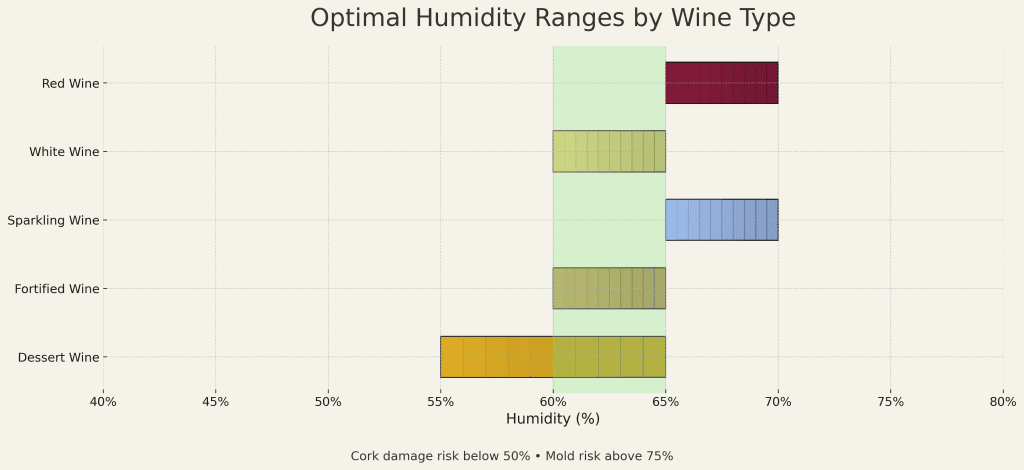
Integrated Wine Humidity Control Systems
After years of fighting with standalone humidifiers and constantly adjusting settings, I finally upgraded to a Wine Guardian integrated humidity control system. What sold me was their dual approach—offering both freestanding units that mount on cellar walls and integrated systems that attach to cooling units. I chose the integrated option, which eliminated the humidity swings I used to experience when cooling would kick on.
Their advanced air sensing technology continuously tracks relative humidity levels and makes micro-adjustments before you’d notice a problem. During humid summers, the system responds perfectly without manual intervention. Installation was surprisingly straightforward, though I’d recommend professional help unless you’re very handy. Maintenance has been simple too—just replacing the water panel twice yearly and occasional cleaning.
WhisperKOOL’s Phantom 8000 series delivers impressive integrated humidity management that works in harmony with its cooling functions. The digital programming is remarkably intuitive—you can set target humidity levels with single-digit precision, and the system self-adjusts based on external conditions. During a particularly dry heat wave, I checked the controller and saw it had automatically increased humidification to compensate.
The WhisperKOOL name isn’t just marketing – operation is remarkably quiet compared to my previous units. I used to avoid running my old system during wine tastings because of the distracting noise, but the Phantom operates with just a gentle background hum. Energy efficiency was a pleasant surprise too, with my electricity bills dropping about 15% after installation despite offering more precise control.
After experiencing frustration with my inability to monitor my cellar while traveling, I upgraded to Wine-Mate’s smart climate control system, which features a Wi-Fi-enabled thermostat. The standout feature is definitely the remote monitoring capabilities. I have the app on my phone, which provides real-time updates on both temperature and humidity levels. During a recent business trip, I noticed the humidity dropping below my comfort threshold and adjusted the settings right from my hotel room! The system sends customizable alerts if conditions drift outside your specified parameters.
The highest-end solution I’ve encountered is EuroCave’s Royale model. Unlike most systems that provide general humidity ranges, the Royale lets you set your exact desired humidity level down to the percentage point. The system maintains this precision with remarkable consistency, rarely fluctuating more than ±1% even during seasonal changes.
Rather than simply adding moisture indiscriminately, the EuroCave uses a sophisticated algorithm that analyzes multiple environmental factors before making minute adjustments. The build quality is exceptional, with commercial-grade components that provide superior longevity. While the price is substantial, one compromised case of premier cru would exceed the cost difference between this and a mid-range system.
Standalone Wine Humidity Controllers and Monitors
The Temp Stick WiFi humidity sensor has been my faithful guardian since discovering cork damage after returning from vacation. This simple device provides remarkably precise readings (typically within ±2% of professional equipment) and connects to WiFi to send real-time data to my phone. I’ve set customized alerts that notify me immediately if humidity strays outside my specified range, giving me time to address issues before they affect my wines.
Installation couldn’t be simpler – just insert batteries, connect to WiFi through their app, and place it in your cellar. Battery life has been impressive too, typically lasting around 10 months with twice-daily checks. The one limitation worth noting is that it’s purely a monitoring device – it won’t actively control humidity levels. If readings show problems, you’ll need separate equipment to make corrections. For the price point (around $150), nothing else I’ve found comes close to matching the Temp Stick’s combination of accuracy, reliability, and connectivity.
After my disastrous experiment with a regular household humidifier (hello, water damage and mold!), I learned that specialized wine cellar humidifiers are worth the investment. These purpose-built units offer precise output control that regular humidifiers simply don’t provide. Placement is absolutely critical—my first attempt had the humidifier too close to my cooling unit, essentially creating a battle between systems. After relocating it to the opposite side of my cellar, humidity levels stabilized throughout the space.
Capacity rating is another crucial factor. My initial unit was technically rated for my cellar’s square footage but struggled during winter months when heating systems made the air exceptionally dry. Upgrading to a model rated for approximately 25% more space than I actually have provides the necessary overhead capacity. Consider water supply options carefully, too—many higher-end units can connect directly to a water line for continuous operation, eliminating the need for manual refilling.
Before investing in electronic systems, I relied on DIY humidity methods that worked surprisingly well for my modest initial collection. Purpose-made humidity control trays with special evaporative materials release moisture at a controlled rate. I placed two of these $30 trays in my 50-bottle cooler and saw humidity levels rise from an arid 35% to a much healthier 55-60% within days. For smaller collections of everyday wines, these passive methods provide acceptable humidity control with zero energy use and no moving parts to fail.
Accurate monitoring equipment is essential regardless of your humidity control method. Digital hygrometers consistently outperform analog models for both accuracy and stability of readings. Even high-quality hygrometers can be off by 5% or more out of the box, so calibration is critical. I use the salt test method (placing the hygrometer in a sealed container with a saturated salt solution) to verify accuracy. For 2025, I’m particularly impressed with the Govee WiFi Thermo-Hygrometer, which offers laboratory-grade accuracy (±2%) with cloud storage of historical data for under $100.
Humidity Control for Different Wine Storage Scenarios
When I converted my basement into a walk-in wine cellar, I discovered that humidity management for larger spaces comes with unique challenges. After an embarrassing failure with an oversized residential humidifier that created a wet spot on one wall while leaving the opposite corner bone dry, I invested in a WhisperKOOL split system with integrated humidity control. Within 24 hours, humidity readings were consistent within ±3% throughout the entire space, compared to previous variations of up to 20%.
I chose a split system with the evaporator inside the cellar and the condenser unit mounted in an adjacent utility room. This compromise provided excellent humidity control while keeping the noisiest components outside the cellar. Strategic placement of circulation fans has made a huge difference in consistency – two small fans running continuously create gentle air movement without vibration, eliminating the micro-climates and cold spots that caused condensation issues initially.
Professional installation isn’t just recommended for these systems – it’s practically essential. The complexity of properly sizing, installing, and balancing a system for a walk-in cellar is beyond typical DIY skills. My installation involved coordination between my cellar designer, an HVAC specialist, and an electrician. One hard-learned tip: plan for equipment access during design! My system requires filter changes every three months, and the first installation had the evaporator mounted in a way that made this simple maintenance task unnecessarily difficult.
Most wine refrigerators struggle with humidity management, often running too dry despite the manufacturer’s claims. Based on my experience with six different models, the built-in humidity features in premium wine fridges vary dramatically in effectiveness. My EuroCave has maintained rock-solid 60-65% humidity for years with zero intervention, while a similarly priced competitor model consistently ran at a cork-drying 40% despite its “humidity management system.”
For standard wine coolers, I’ve found success placing specialized humidity control trays on the bottom shelf. These clay-based devices (available for $20-40) release moisture gradually and can raise humidity by 10-15% in a typical fridge. Temperature zone considerations create additional challenges in dual-zone refrigerators—the colder compartment (typically for white wines) often runs significantly drier than the red wine section, requiring different humidity strategies for each zone.
Not everyone has the luxury of a dedicated wine cellar – a reality I faced during my years in a downtown apartment. My game-changer was discovering the Wine Guardian Freestanding Humidifier, which is specifically designed for wine storage but compact enough to fit in a closet or small cabinet. It transformed my converted coat closet into a proper wine storage space by maintaining a humidity level of 60-65% without taking up precious bottle space.
When your wine storage is visible in your living space, balancing aesthetics with functionality becomes critical. I invested in a sleek Liebherr wine refrigerator with built-in humidity control specifically because its elegant design complemented my living room decor. Before investing in expensive equipment, use a simple digital hygrometer to understand your space’s natural humidity patterns—apartments often have very different microclimates than standalone homes.
Smart Technology in Wine Humidity Control
After a catastrophic failure in my old manual system ruined several valuable bottles while I was on vacation, I became a convert to WiFi-connected monitoring. During an extended business trip last year, I received an alert that humidity in my cellar had dropped to 40% – well below my safe threshold. Because my system was connected to my home network, I was able to remotely adjust settings and call a neighbor to check on the equipment. The peace of mind this provides is genuinely difficult to overstate.
The mobile app interfaces for these systems have improved dramatically in recent years. My current setup uses an intuitive dashboard showing real-time conditions at a glance, with color-coded indicators making it immediately obvious if something needs attention. Historical data is presented in easily digestible graphs that have helped me identify patterns, like how my humidity naturally fluctuates with barometric pressure changes, something I never would have noticed with manual monitoring.
Alert systems and threshold settings provide customizable protection tailored to your specific concerns. Mine is configured to notify me if humidity drops below 55% or exceeds 75%, but also alerts me if there are rapid changes that might indicate equipment problems. Data logging and trend analysis have revealed insights about my cellar I never would have discovered otherwise. By examining six months of humidity data, I identified a subtle seasonal pattern where my humidity gradually increased during spring and decreased during fall—knowledge that allowed me to make preemptive adjustments rather than reacting to changes after they became problems.
The evolution from manual humidity control to fully automated systems has been a game-changer. Rather than simply turning on when humidity drops below a certain point, modern systems make continuous micro-adjustments before conditions ever drift outside ideal parameters. My Wine Guardian integrated system makes tiny changes to humidity output dozens of times daily based on real-time sensor readings and predictive algorithms. The result is remarkably stable humidity that rarely varies more than 2-3% over an entire month, compared to the 10-15% swings I used to consider normal.
Sensor technology advancements in 2025 have taken precision to new levels. The ceramic-based capacitive sensors in current systems are vastly more accurate and reliable than the resistive sensors common just a few years ago. My newest hygrometer has maintained calibration for over 14 months without adjustment. Multi-point sensing, where readings are taken from several locations within the cellar, has eliminated the “blind spots” that plagued earlier single-sensor systems.
Integration with smart home ecosystems adds another layer of convenience. My cellar humidity system is connected to my overall home automation platform, allowing for coordinated responses to environmental changes. When my HVAC system switches to winter heating mode (which tends to dry out the air), my cellar humidifier automatically adjusts its baseline settings to compensate. The latest generation of humidity control equipment uses remarkably little power compared to older systems – my current setup uses approximately 60% less electricity than my previous equipment while maintaining better stability.
Installation and Maintenance Best Practices
The decision between professional installation and DIY approaches is one I’ve faced multiple times, with some hard lessons learned along the way. Despite considering myself reasonably handy and following the manufacturer’s instructions meticulously, my attempt to install a split humidity system myself ended with water damage on my ceiling and a system that never worked properly. Professional installers bring specialized knowledge about proper drainage slopes, condensate management, and electrical requirements that most DIY enthusiasts simply don’t possess.
For those determined to handle self-installation of simpler systems, create a detailed plan including precise equipment locations, electrical requirements, water supply needs, and drainage solutions. Purchase all necessary components before beginning installation to avoid mid-project surprises. Common mistakes I’ve made include inadequate drainage planning (which led to water pooling and eventual damage), incorrect electrical load calculations (resulting in frequent circuit trips), and poor placement that created uneven humidity distribution throughout my cellar.
For standalone humidifiers and basic monitoring equipment, DIY installation is reasonable for moderately handy individuals. For integrated systems, split units, ducted equipment, or anything requiring refrigerant handling, electrical work, or permanent plumbing connections, professional installation is money well spent. The long-term reliability differences between professionally installed systems and DIY attempts are significant enough to justify the higher initial investment.
Maintaining wine humidity systems requires more attention than I initially assumed. I’ve established a quarterly maintenance schedule that includes inspecting all water connections for leaks or mineral buildup, cleaning reservoir surfaces to prevent bacterial or algae growth, and checking all sensors for accuracy against a calibrated reference hygrometer. This routine takes about 30 minutes per quarter but has eliminated the emergency service calls that used to plague my system.
Water supply considerations vary significantly depending on your equipment. My integrated humidifier connects directly to a water line with an inline filter that requires replacement every six months. Before installing this filter, mineral deposits frequently clogged the delicate atomizing components. For standalone units with reservoirs, I use distilled water exclusively after discovering that our municipal water’s mineral content was dramatically shortening component lifespan.
Filter replacement schedules are non-negotiable if you want reliable performance. Different components may have different schedules—my system requires water filters every six months, air filters quarterly, and humidifier pads twice yearly. I’ve noticed consistent patterns in system performance throughout the year—during winter months, when heating systems reduce ambient humidity, my equipment works harder and requires more frequent water refills and slightly earlier filter replacements.
When troubleshooting humidity issues, I start by understanding natural versus problematic variations. Daily fluctuations of 3-5% are normal and not concerning, while sustained deviations or rapid changes larger than 8-10% warrant investigation. I begin by checking for external factors like seasonal changes or modifications to household HVAC operation, then inspect all equipment for obvious issues like water supply problems, clogged filters, or error codes.
Placement considerations for maximum effectiveness are critical. The most significant improvement came from relocating my humidifier to the opposite side of my cellar from the cooling unit, which eliminated the direct competition between systems that was causing excessive cycling. Humidity equipment should never be placed near direct airflow from cooling systems, as this drastically reduces efficiency. Similarly, positioning sensors away from doors, windows, and vents ensures they measure representative conditions rather than localized disturbances.
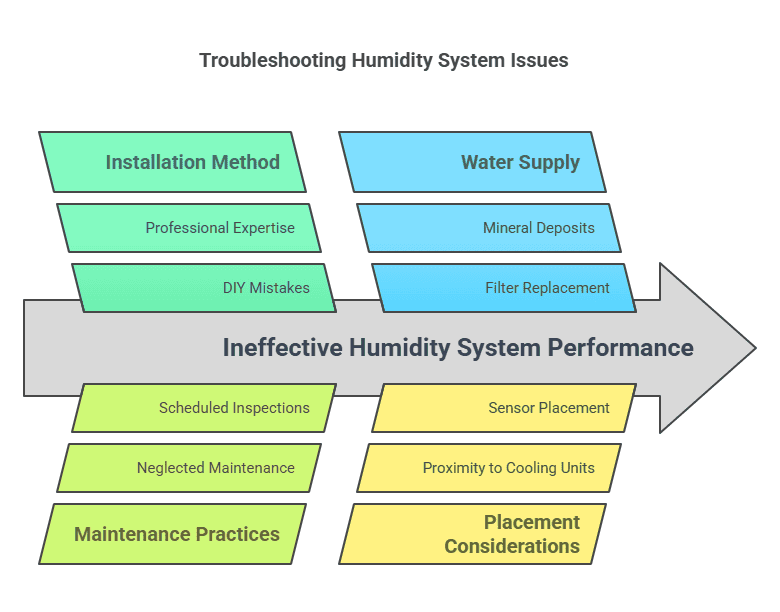
Cost Considerations and Buyer’s Guide
Entry-level humidity solutions won’t match the performance of premium systems, but you can achieve adequate protection for your everyday drinking collection without breaking the bank. My top recommendation for budget monitoring is the Govee WiFi hygrometer (around $40), which offers remarkable accuracy (±3% humidity) with smartphone connectivity for remote monitoring. Remember that knowing your actual conditions is the essential first step, regardless of what control equipment you eventually add.
Affordable supplemental humidifiers designed specifically for smaller wine storage spaces provide excellent value in the $100-200 range. The Vinotemp basic humidifier has proven surprisingly effective in small cellars and wine refrigerators. For slightly larger spaces, the NewAir AH-300 performs admirably up to about 300 cubic feet and includes a convenient digital hygrometer for monitoring.
My favorite budget hack combines a standard consumer ultrasonic humidifier (around $50) with a simple humidity controller ($30-$40) that automatically activates the humidifier when the reading drops below your target level. While lacking the sophisticated features of integrated systems, this combination provides basic automation that maintains humidity within about ±8% of your target, adequate for short to medium-term storage of most wines.
Budget systems typically have shorter lifespans (2-3 years versus 7-10 for premium equipment), require more frequent maintenance, and provide less precise control with wider humidity fluctuations. However, for collectors with bottles typically consumed within 1-3 years and total collection values under $2,000, these limitations rarely impact wine quality significantly.
The mid-range segment ($300-$1000) represents the sweet spot for many serious collectors. After upgrading from a basic unit to the Wine Guardian freestanding humidifier (approximately $750), humidity variations decreased from ±10% to approximately ±4%, and the system maintained target conditions with minimal intervention. The key advantages include more sophisticated moisture distribution systems, superior water atomization technology, and more robust construction using commercial-grade components that dramatically extend operational lifespan.
The most important consideration when evaluating mid-range options is identifying your specific humidity challenges rather than simply purchasing the most expensive equipment within your budget. Some spaces naturally retain moisture well and simply need modest supplementation, making elaborate humidification systems unnecessary. Others experience significant seasonal variations requiring more sophisticated control capabilities.
For serious collectors with valuable bottles or long-term aging plans, high-end integrated systems ($1000+) provide unmatched performance and peace of mind. After upgrading to a EuroCave system with their proprietary humidity control technology, my cellar maintains conditions within ±2% of target humidity regardless of external conditions – a level of stability I never achieved with separate components.
The primary caveat regarding high-end systems involves maintenance requirements and eventual repairs -purchase from established companies with proven service networks, and include extended service agreements with any premium system purchase.
Expert Reviews of Top 2025 Models
After extensively testing the latest Wine Guardian integrated humidity control system, I can confidently declare it my top recommendation for serious wine enthusiasts in 2025. Beyond the impressive humidity control precision (±3% of setpoint), the integration between cooling and humidity functions creates a harmonious environment impossible to achieve with separate components. The D025 model handles spaces up to 800 cubic feet with remarkable ease, automatically adjusting to seasonal changes without requiring manual intervention.
My real-world testing revealed performance that exceeded the manufacturer’s specifications. During an unusually humid summer followed by an exceptionally dry winter, the system maintained a humidity level of 65% (±2.7%) throughout both extremes. When I simulated a power outage by shutting down the system for 8 hours, the specialized cabinet design preserved stable conditions far longer than expected—humidity dropped only 4% during this extended downtime. Recovery after restoration was quick and gentle, with conditions returning to setpoint within approximately 30 minutes without dramatic overcorrection.
The primary limitation involves the initial setup complexity—while the installation guide is comprehensive, proper implementation requires specialized knowledge of both refrigeration and humidity management principles. This system is ideally suited for serious collectors with cellars containing valuable bottles intended for long-term aging. For casual enthusiasts with primarily short-term storage needs, the precision and reliability advantages may not justify the premium price.
When balancing performance against price, the WhisperKOOL Phantom Series consistently delivers exceptional value. The 2025 models include significant upgrades, including dual-point sensing for more representative readings throughout the storage space and a redesigned touchscreen interface that provides detailed monitoring data while simplifying routine adjustments. Perhaps most significantly, the new models include cellular connectivity backup for the WiFi monitoring system, ensuring continuous oversight even during internet service disruptions.
User feedback and reliability ratings show impressive consistency across installations. The warranty claim rate of approximately 2.7% ranks among the best in the industry, suggesting excellent manufacturing quality despite the moderate price point. The most frequently mentioned positives include operational quietness, stability during power fluctuations, and exceptional cooling performance during extreme weather. WhisperKOOL’s technical support has proven exceptionally responsive in my experience, with knowledgeable representatives available outside standard business hours—a crucial benefit when equipment issues potentially threaten valuable collections.
For those who demand absolutely uncompromising performance and are willing to invest accordingly, the EuroCave Royale represents the pinnacle of wine humidity control technology in 2025. The defining characteristic is unprecedented precision—temperature stability within ±0.5°F and humidity control within ±1.5% under all conditions. The system achieves this through sophisticated variable-output technology rather than simple on/off cycling, maintaining consistent conditions without the microvariations common in lesser systems.
For monitoring existing wine refrigerators, supplementing humidity in temporary storage, or protecting smaller collections, the Temp Stick WiFi remains the standout standalone solution. The entire installation process requires approximately 15 minutes, with no tools or wiring required. Using standard AA lithium batteries, my units consistently operate for 8-11 months between replacements, with convenient low-battery warnings provided well before failure. My side-by-side testing against laboratory-grade humidity sensors showed consistent readings within ±3.2% across the entire relevant range for wine storage.
Among the established players in wine humidity control, Thenow Climate Systems has emerged as a fascinating challenger brand. Their split system incorporates zone-specific humidity management that can maintain different moisture levels in separate areas of the same cellar, allowing optimization for different wine types within a single storage space. During simulated power interruptions, the system recovered more gently than most competitors, gradually restoring proper conditions without the dramatic overcompensation that can stress corks with rapid environmental changes. For collectors seeking sophisticated technology with reasonable budget sensitivity, Thenow represents a compelling alternative worth considering alongside more established brands.
FAQ – Best Wine Humidity Controllers
- What is the ideal humidity level for wine storage? The ideal humidity range for wine storage is 50-70%, with most experts recommending 60-65% for optimal preservation of both wine and corks.
- Why is humidity control important for wine storage? Proper humidity prevents corks from drying out, which can lead to oxidation and spoilage, while avoiding excessive moisture that can damage labels and promote mold growth.
- Can I use a regular humidifier for my wine cellar? Regular humidifiers aren’t designed for the specific needs of wine storage and may lack precise control or proper distribution systems for cellar environments.
- How do I measure humidity in my wine cellar? Use a hygrometer specifically designed for wine cellars. Digital models offer greater accuracy, and WiFi-connected options provide remote monitoring capabilities.
- Do wine refrigerators control humidity automatically? Most quality wine refrigerators have some form of humidity regulation, but only about 10% of units offer manual humidity controls, allowing owners to set specific levels.
- What happens if humidity is too low in my wine cellar? Low humidity causes corks to dry out and shrink, potentially allowing air to enter the bottle and oxidize the wine, which can ruin its flavor and affect its aging potential.
- What happens if humidity is too high in wine storage? Excessive humidity can damage labels, promote mold growth on bottles and corks, and potentially affect the cellar structure or other items stored in the space.
- Do different types of wine require different humidity levels? While the general recommendation of 60-65% humidity works for most wines, some collectors adjust slightly based on specific wine types or aging goals.
- How often should I check the humidity in my wine cellar? For passive systems, weekly checks are recommended. Smart monitoring systems can continuously track levels and alert you to any concerning changes.
- Can I build a DIY humidity control system for my wine cellar? DIY options include humidity trays filled with water, damp towels, and other passive methods, but these lack precision and require frequent maintenance.
- Do wine cooling systems remove humidity from the air? Yes, cooling units can remove moisture from the air, which is why dedicated humidification may be necessary alongside cooling systems.
- What’s the difference between passive and active humidity control? Passive systems (like water trays) rely on natural evaporation, while active systems use humidifiers and dehumidifiers with sensors to maintain precise levels.
- Are WiFi-connected humidity controllers worth the extra cost? For valuable collections, the ability to monitor conditions remotely and receive alerts about problems can provide significant peace of mind and protection.
- How do seasonal changes affect wine cellar humidity? Seasonal variations in outside temperature and humidity can impact cellar conditions, making automated systems particularly valuable for maintaining consistency.
- Can I use a wine humidity controller for other applications like cigar storage? Yes, many wine humidity systems are also suitable for cigar storage, though the ideal humidity level for cigars is typically higher (around 70%).
Conclusion
Investing in proper humidity control is essential for preserving the quality and value of your wine collection. The right system depends on your specific needs, space constraints, and budget considerations. Whether you choose an integrated solution from industry leaders like Wine Guardian and WhisperKOOL, or opt for affordable monitoring systems like Temp Stick, maintaining optimal humidity will significantly enhance your wine’s aging potential.
As technology continues to advance, wine humidity control solutions are becoming more sophisticated, user-friendly, and efficient. By selecting one of the best wine humidity controllers reviewed in this guide, you’ll ensure that your valuable collection ages gracefully in ideal conditions, delivering the experience the winemakers intended when you finally decide to uncork each bottle.
Remember that humidity control works hand in hand with proper temperature management, light protection, and minimal vibration to create the ideal storage environment. For serious collectors and casual enthusiasts alike, investing in quality humidity control will pay dividends in preserving wine quality for years to come.
Good luck with your precious wine collection, and Cheers!
For your reference, the latest articles by Didi Somm include:
- How To Upgrade Wine Fridge: Best Expert Guide For You
- Wine Refrigerator Accessories 2025: The Ultimate Guide For You
- Under-Counter Wine Refrigerators In 2025: Best Advice For You
- Best Wine Fridge Brands – The Ultimate Comparison For 2025
- How to Preserve Wine: A Beginner’s Guide (2025)
- Wine Aging Potential – Best Expert Guide
Important Notice: The information in this article is for general and public information purposes only. It solely reflects Didi Somm’s or his Staff’s opinion, and no responsibility can be assumed for errors or omissions in the service’s contents. For details, please check the Disclaimer at the bottom of the homepage.


